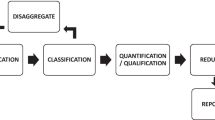Abstract
Purpose
Quantitative uncertainties are a direct consequence of averaging, a common procedure when building life cycle inventories (LCIs). This averaging can be amongst locations, times, products, scales or production technologies. To date, however, quantified uncertainties at the unit process level have largely been generated using a Numerical Unit Spread Assessment Pedigree (NUSAP) approach and often disregard inherent uncertainties (inaccurate measurements) and spread (variability around means).
Methods
A decision tree for primary and secondary data at the unit process level was initially created. Around this decision tree, a protocol was developed with the recognition that dispersions can be either results of inherent uncertainty, spread amongst data points or products of unrepresentative data. In order to estimate the characteristics of uncertainties for secondary data, a method for weighting means amongst studies is proposed. As for unrepresentativeness, the origin and adaptation of NUSAP to the field of life cycle assessment are discussed, and recommendations are given.
Results and discussion
By using the proposed protocol, cross-referencing of outdated data is avoided, and user influence on results is reduced. In the meantime, more accurate estimates can be made for horizontally averaged data with accompanying spread and inherent uncertainties, as these deviations often contribute substantially towards the overall dispersion.
Conclusions
In this article, we highlight the importance of including inherent uncertainties and spread alongside the NUSAP pedigree. As uncertainty data often are missing in LCI literature, we here describe a method for evaluating these by taking several reported values into account. While this protocol presents a practical way towards estimating overall dispersion, better reporting in literature is promoted in order to determine real uncertainty parameters.



Similar content being viewed by others
References
Björklund AE (2002) LCA methodology survey of approaches to improve reliability in LCA. Int J Life Cycle Assess 7(2):64–72
da Silva VP, van der Werf HMG, Spies A, Soares SR (2010) Variability in environmental impacts of Brazilian soybean according to crop production and transport scenarios. J Environ Manage 91:1831–1839
Finkbeiner M (2009) Carbon footprinting—opportunities and threats. Int J Life Cycle Assess 14:91–94
Frischknecht R, Jungbluth N, Althaus H-J, Doka G, Dones R, Heck T, Hellweg S, Hischier R, Nemecek T, Rebitzer G, Spielmann M, Wernet G (2007) Overview and methodology. ecoinvent Report No. 1. Dübendorf
Funtowicz SO, Ravetz JR (1990) Uncertainty and quality in science for policy. Kluwer, Dordrecht
Heijungs R (1996) Identification of key issues for further investigation in improving the reliability of life-cycle assessments. J Clean Prod 4:159–166
Henriksson PJG, GuinéeJB KR, Snoo GR (2011) Life cycle assessment of aquaculture systems—a review of methodologies. Int J Life Cycle Assess 17:304–313
Huijbregts MAJ (1998a) Application of uncertainty and variability in LCA. Part I: a general framework for the analysis of uncertainty and variability in life cycle assessment. Int J Life Cycle Assess 3:273–280
Huijbregts MAJ (1998b) Application of uncertainty and variability in LCA. Part II: dealing with parameter uncertainty and uncertainty due to choices in life cycle assessment. Int J Life Cycle Assess 3:343–351
Huijbregts MAJ, Norris G, Bretz R, Ciroth A, Maurice B, von Bahr B, Weidema B, de Beaufort ASH (2001) Framework for modelling data uncertainty in life cycle inventories. Int J Life Cycle Assess 6:127–132
ISO (2006) Environmental management—life cycle assessment—requirements and guidelines (ISO 14044:2006). Geneva, Switzerland
de Koning A, Schowanek D, Dewaele J, Weisbrod A, Guinée J (2009) Uncertainties in a carbon footprint model for detergents; quantifying the confidence in a comparative result. Int J Life Cycle Assess 15:79–89
Lazarevic D, Buclet N, Brandt N (2012) The application of life cycle thinking in the context of European waste policy. J Clean Prod 29–30:199–207
Limpert E, Stahel WA, Abbt M (2001) Log-normal distributions across the sciences: keys and clues. BioScience 51:341–352
Lloyd SM, Ries R (2007) Characterizing, propagating, and analyzing uncertainty in life-cycle assessment: a survey of quantitative approaches. J Ind Ecol 11:161–179
Morgan MG, Henrion M (1990) Uncertainty: a guide to dealing with uncertainty in quantitative risk and policy analysis. Cambridge University Press, New York
Ortiz M, Arocha F (2004) Alternative error distribution models for standardization of catch rates of non-target species from a pelagic longline fishery: billfish species in the Venezuelan tuna longline fishery. Fish Res 70:275–297
Ravetz JR (1999) What is post-normal science. Science 31:647–653
Ross S, Evans D, Webber M (2002) How LCA studies deal with uncertainty. Int J Life Cycle Assess 7:47–52
UNEP (2011) Global guidance principles for life cycle assessment databases—a basis for greener processes and products. UNEP/SETAC life cycle initiative report. SETAC Press, Paris
van der Sluijs JP, Craye M, Funtowicz S, Kloprogge P, Ravetz JR, Risbey J (2005) Combining quantitative and qualitative measures of uncertainty in model-based environmental assessment: the NUSAP system. Risk Anal 25(2):481–491
Weidema B, Wesnaes MS (1996) Data quality management for life cycle inventories—an example of using data quality indicators. J Clean Prod 4:167–174
Weidema BP, Bauer C, Hischier R, Mutel C, Nemecek T, Reinhard J, Vadenbo CO, Wernet G (2012) Overview and methodology. Data Quality Guideline for the ecoinvent Database version 3. ecoinvent Report 1. St. Gallen
Williams ED, Weber CL, Hawkins TR (2009) Hybrid framework for managing uncertainty in life cycle inventories. J Ind Ecol 13:928–944
Acknowledgments
This work is part of the Sustaining Ethical Aquaculture Trade (SEAT) project, which is co-funded by the European Commission within the Seventh Framework Programme—Sustainable Development Global Change and Ecosystem (project no. 222889). http://www.seatglobal.eu.
Author information
Authors and Affiliations
Corresponding author
Additional information
Responsible editor: Andreas Ciroth
Electronic supplementary material
Below is the link to the electronic supplementary material.
ESM 1
(XLSX 410 kb)
Rights and permissions
About this article
Cite this article
Henriksson, P.J.G., Guinée, J.B., Heijungs, R. et al. A protocol for horizontal averaging of unit process data—including estimates for uncertainty. Int J Life Cycle Assess 19, 429–436 (2014). https://doi.org/10.1007/s11367-013-0647-4
Received:
Accepted:
Published:
Issue Date:
DOI: https://doi.org/10.1007/s11367-013-0647-4




